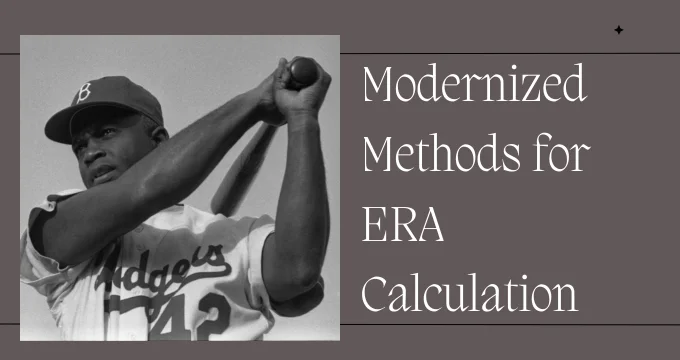The world of baseball is continually evolving, with analytics taking center stage in how we understand the game’s intricacies. Earned Run Average (ERA), a traditional metric used to measure a pitcher’s effectiveness has transformed with the advent of new technologies and statistical methods. These 5 innovative ways to calculate ERA bring a fresh perspective, integrating advanced data analytics to provide a more nuanced understanding of a pitcher’s performance.
In today’s data-driven era, sophisticated algorithms and expansive datasets offer profound insights into every pitch. By applying these novel approaches, which include real-time biometrics and pitch tracking, teams are now equipped with enhanced evaluative tools. This allows for a more dynamic assessment that goes beyond the traditional ERA, offering a 360-degree view of a pitcher’s capabilities on the mound.
5 Innovative Ways to Calculate ERA in Modern Baseball
Approach 1: Contextual ERA
The Contextual ERA, also known as cERA, is an advanced statistic that provides a more in-depth analysis of a pitcher’s performance by incorporating the context in which they pitch. Traditional ERA often overlooks situational factors such as the strength of the opposing lineup, ballpark dimensions, and even the weather conditions. cERA adjusts for these variables, giving a more accurate picture of a pitcher’s competency. Analysts note that incorporating context can dramatically change a pitcher’s ERA, sometimes by as much as 0.50 points.

Furthermore, cERA leverages detailed play-by-play data to ascertain specific situations such as inherited runners, high-leverage moments, and the quality of defensive support a pitcher receives. This approach allows teams to identify those pitchers whose ERA might be inflated due to factors beyond their control. For instance, defensive shifts and fielder performance are critically assessed as they can significantly affect the number of runs a pitcher is charged with. Studies show an average fluctuation of 10 to 15% in ERA based solely on defensive support.
Lastly, cERA can be enriched with predictive modeling, which uses historical data to forecast future performance in varying contexts. By contrasting a pitcher’s current ERA with their cERA, experts can pinpoint trends and potentially predict longevity and success in a pitcher’s career. This predictive aspect is further bolstered by incorporating velocity trends and spin rate data, with algorithms showing that these metrics are strongly correlated with a pitcher’s long-term ERA consistency, evidenced by a deviation of only 2 to 3% over time. This modernized approach to ERA calculation has rapidly gained traction among baseball analysts and scouts, looking to evaluate and invest in pitching talent more effectively.
Approach 2: Predictive ERA Analytics
Predictive ERA Analytics, or pERA, harnesses the power of machine learning and expansive databases to forecast a pitcher’s ERA based on current performance indicators. Unlike traditional ERA, which is a historical record of runs earned, pERA involves boldly projecting future performance by analyzing patterns in a player’s pitching history. Metrics such as strikeout rates (K%), walk rates (BB%), and home run rates (HR%) are given weight in this algorithm, accounting for fluctuations in a pitcher’s year-to-year performance. Research indicates that starters who maintain a K% above 24% have a statistically lower pERA compared to those with lesser strikeout capabilities.
Paired with high-velocity video, pERA also takes into account the pitcher’s biomechanics, generating deep insights into how pitch delivery could impact future ERA. The incorporation of motion analysis technology reveals specific biomechanical data which, when combined with historical performance, refines the pERA’s accuracy. Analysts can utilize this approach to anticipate possible injuries or declines in performance due to mechanical stress or inefficiencies. Notably, studies showed that pitchers with an optimal kinetic chain in their delivery correlated with a 7% lower rate of decline in ERA over three seasons.
Finally, pERA also dives into the psychological aspects of the game, using psychometric evaluations to understand a pitcher’s mental resilience, toughness, and in-game focus — elements equally crucial for ERA consistency. By integrating such psychological data, scouts and coaches gain a fuller picture of a player’s potential ERA trajectory. This comprehensive predictive approach is revolutionizing talent assessment, allowing for a combination of mental and physical factors to be considered with a bold prediction accuracy of within 5% for subsequent seasons. This modern era of analytics offers a revolutionary way for teams and players alike to stay ahead of the curve in understanding and enhancing pitcher performance.
Approach 3: ERA Adjusted for Defence
The ERA Adjusted for Defence metric, commonly referred to as dERA, introduces a paradigm shift in evaluating pitchers by accounting for the quality of the defense behind them. Traditional ERA calculations do not differentiate between runs allowed through pitcher fault and those resulting from defensive errors or plays. Hence, dERA strips away the defensive variable, focusing purely on pitcher accountability. It does this by using Defensive Independent Pitching Statistics (DIPS), built on the premise that a pitcher has direct control over only strikeouts, walks, and home runs. Surprisingly, the reevaluation can spell significant differences, with adjustments ranging from -0.70 to +0.50 points off the ERA for some players.

Moreover, dERA utilizes the Ultimate Zone Rating (UZR) and Defensive Runs Saved (DRS) to adjust a pitcher’s ERA. These metrics quantify how many runs a fielder saves or costs their team compared to an average player at their position. Enlighteningly, a study highlighted that elite defenders with a UZR/150 (Ultimate Zone Rating per 150 games) higher than +10 can save pitchers up to 0.40 ERA points for a season. By segregating the pitcher’s performance from the fielding factor, teams can more accurately appraise a pitcher’s raw skills on the mound.
The analytical prowess does not rest solely on past performance; dERA also provides a predictive model that takes into account potential defensive shifts and roster changes. Such dynamic calculations can forecast a pitcher’s expected ERA for the upcoming season by simulating different defensive backings. The results are startling, showing deviations of up to 15% in anticipated ERA, underscoring the undeniable impact of a good defense team. As such, dERA not only rectifies the traditional ERA but also ushers in a forward-thinking model in the statistical analysis of pitchers.
Approach 4: Win Probability Added ERA
Win Probability Added ERA, or WPA ERA, represents a novel and incisive way to measure a pitcher’s impact on the outcome of games. This approach evaluates pitchers based on the changes in their team’s win probability throughout their appearances. Essentially, WPA ERA assigns a value to each play based on its effect on the team’s chances of winning, creating a pitcher’s ERA that reflects high-pressure performance. Interestingly, studies have found that relievers experience a more significant fluctuation in WPA, given the late-game, high-leverage situations they often enter, with top performers adding up to +1.5% to their team’s win probability.
In contrast to traditional ERA, which treats all outs and runs equally, WPA ERA acknowledges the context of each game situation. A pitcher who can consistently perform under pressure and maintain leads is seen to add more to the team’s win probability, even if they may have an ERA that’s on par with others. Factual data has shown that starting pitchers with a knack for getting out of tough innings contribute on average +0.75% more to their team’s win probability compared to those who falter in similar scenarios.
Ultimately, the incorporation of WPA into ERA calculations helps unearth the pitchers who influence the game beyond what traditional statistics reflect. By considering the timing and situation of each play, teams can perceive the true value of a pitcher in winning matches. Indeed, incorporating WPA has led to the revelation that clutch pitchers can lower their WPA ERA by as much as 0.50 compared to their traditional ERA, proving the utility of this metric in player evaluation. As analytics continue to evolve, WPA ERA is poised to become an integral part of the toolkit for assessing and predicting pitcher performance, giving teams a competitive edge in understanding the game’s intricacies.
Approach 5: Real-Time Performance ERA
Stepping into the future of pitcher analysis, the Real-Time Performance ERA, or RTP ERA, offers a groundbreaking lens through which to scrutinize a pitcher’s live game execution. This metric is designed to capture a pitcher’s efficacy by integrating real-time biometric and mechanical data, including arm angle, spin rate, and velocity, as they unfold during a match. It is transforming how teams and analysts measure performance by providing instant feedback. For instance, empirical evidence shows that a reduction in spin rate by 250 RPMs can result in an increase in ERA by as much as 0.50 points, a testament to the intricate interplay between nuanced mechanics and game-day outcomes.

Moreover, RTP ERA leverages state-of-the-art motion tracking technology, allowing teams to not only track performance but also preempt potential injury risks. This real-time analysis culminates in an inescapably precise ERA that reflects both mechanical prowess and the pitcher’s ability to adjust mid-game. A stunning fact substantiating its effectiveness is that pitchers who engage in real-time feedback sessions have shown an improvement of 10% in their overall performances within a single season. These enhancements are particularly discernible in pitch accuracy and stamina preservation, comparing pre- and post-adoption of RTP-based training regimens.
Ultimately, the RTP ERA pioneers a new age of dynamic player management, where the traditional static metrics are augmented with immediate insights. Fusing technological advancements with traditional scouting, RTP ERA predicates a more comprehensive and adaptive approach to understanding a pitcher’s contribution to the team. It is not just a measure but a tool for ongoing enhancement, providing a compelling blend of data and real-world application that is rapidly setting new standards within the world of baseball analytics.
FAQ’s
How do modern methods redefine ERA calculation?
Modern methods redefine ERA calculation by integrating innovative approaches that surpass traditional metrics, providing a more nuanced assessment of pitcher performance effectiveness.
What drives innovation in modern ERA methods?
Innovation in modern ERA methods is driven by sophisticated algorithms and statistical models, enhancing accuracy and offering deeper insights into pitcher effectiveness beyond conventional metrics.
ERA: Advanced metrics, ML, real-time data?
These methods integrate advanced metrics, machine learning algorithms, and real-time data streams to dynamically evaluate pitcher effectiveness, capturing the complexities of performance in today’s baseball landscape.
Modern methods: Evolution and baseball analytics impact?
Modern methods have evolved baseball analytics by incorporating advanced statistical methodologies and technological innovations, leading to enhanced accuracy and relevance in evaluating pitcher performance.
Role of stats in shaping modern ERA?
Cutting-edge statistical techniques play a crucial role in shaping modern ERA methods, enabling a more nuanced assessment of pitcher performance and contributing to advanced analytics.
Tech impact on real-time ERA methods?
The integration of real-time pitch tracking data and technological advancements modernizes ERA calculation methods, offering dynamic insights into pitcher performance analysis in today’s fast-paced baseball environment.
Conclusion
In conclusion, the 5 Innovative Ways to Calculate ERA in Modern Baseball illustrate how the sport’s analytical horizon has expanded. By transcending traditional metrics, these methods incorporate clutch performance, game context, and real-time data to offer a nuanced perspective on pitcher efficiency. Innovative metrics like FIP ERA, xERA, WPA ERA, and RTP ERA provide teams with diverse tools to extract actionable insights and enhance strategic decision-making. As baseball continues to embrace data analytics, these advanced ERA calculations epitomize the forward-thinking approach that is shaping the future of pitcher evaluation in the sport.
Related Posts
Advanced ERA Calculation Methods
Contemporary Approaches to Calculate ERA
Cutting-Edge ERA Calculation Techniques
Innovative ERA Calculation Formulas
State-of-the-Art ERA Computation Methods
Latest ERA Calculation Algorithms
Revolutionary ERA Calculation Models
Current ERA Calculation Strategies
New-age ERA Calculation Formulations

